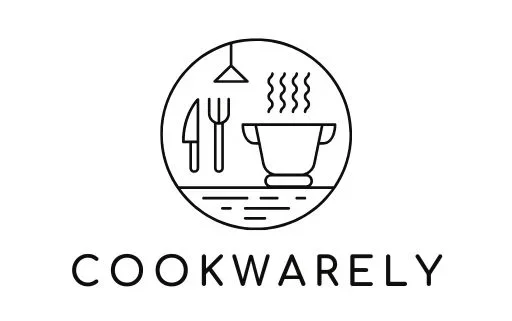Can You Reheat Food in a Chafing Dish?
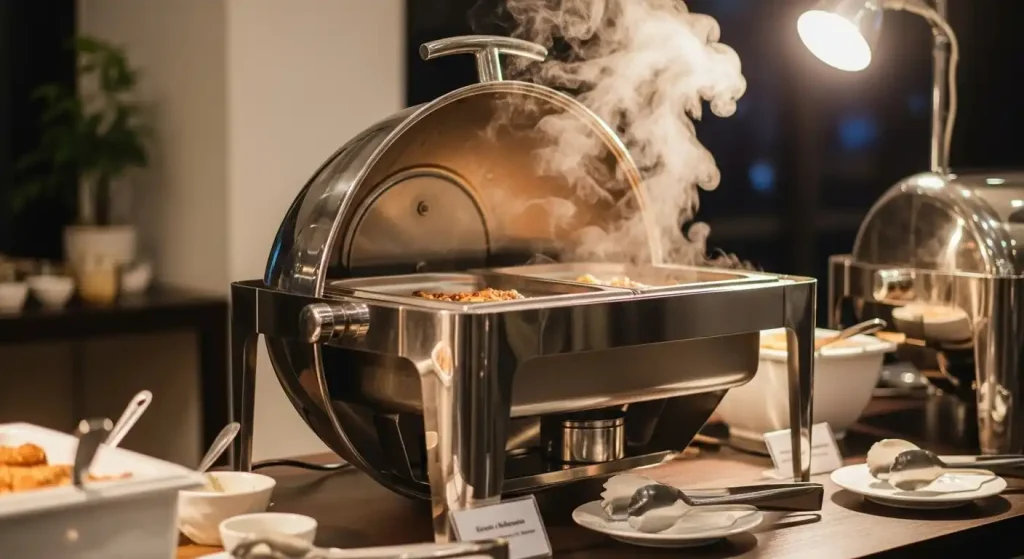
Reheating food in a chafing dish is not recommended. Chafing dishes are designed to maintain the temperature of already hot food, not to heat cold food to a safe internal temperature of at least 165 °F, which is essential for food safety.
A chafing dish is designed to keep preheated food warm using indirect heat from hot water and fuel or electricity.
It is not suitable for reheating cold food, as it may not reach safe serving temperatures.
Food should be reheated first, then placed in the chafing dish for holding.
🎃 Spooky Good Amazon Deals This Fall !
From cozy fall essentials to Halloween must-haves, shop Amazon’s seasonal discounts now. Don’t wait, deals vanish fast!
*As an Amazon Associate, I earn from qualifying purchases.
Key Takeaways
- A chafing dish keeps already-hot food warm using indirect steam heat.
- It is not meant to reheat cold food from fridge temperature.
- Always reheat food fully on a stove, oven, or microwave before using a chafer.
- Keep food at or above 140°F (60°C) to prevent bacterial growth.
- Chafers work best for moist dishes like stews, pasta, and casseroles, not crispy foods.
What is a chafing dish?
A chafing dish is a special serving pan that keeps food warm at parties or buffets.
It has a sturdy frame, a shallow water pan, a food pan, and a lid.
You fill the water pan about 1 inch deep with hot water.
Under the water pan you light a small fuel flame or plug in an electric element.
The hot water gently steams and warms the food pan above it.
In other words, a chafing dish does not cook food; it simply holds already-hot food at a safe serving temperature.
Can You Reheat Food in a Chafing Dish?
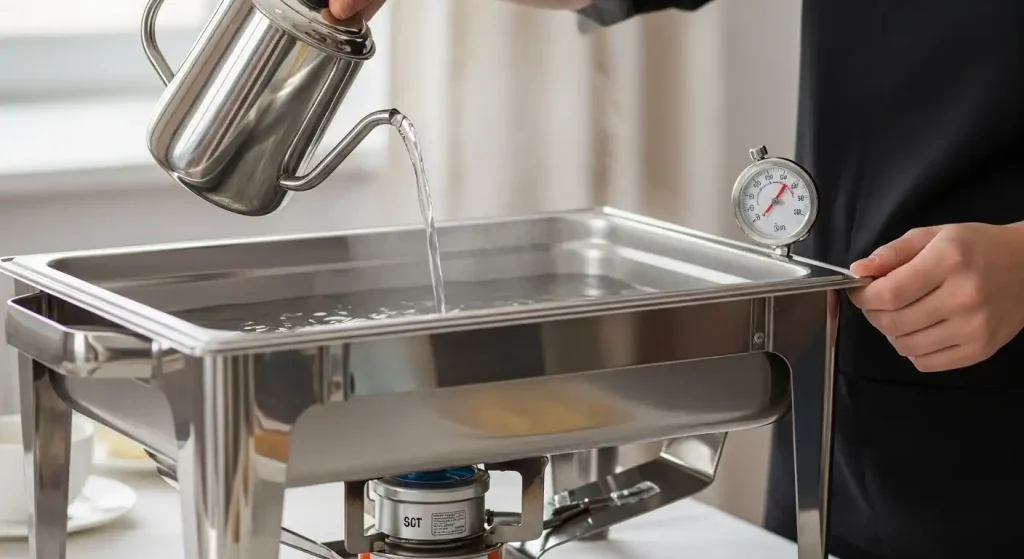
Chafing dishes are designed to hold hot food, not to fully reheat cold food. They work by using gentle heat from the water pan, which is great for keeping already-hot dishes warm.
However, this indirect heat is not as powerful as an oven or stovetop.
In fact, the FDA warns that some buffet warmers only heat up to about 110–120°F, which is below the 140°F needed to keep food safely out of the “danger zone”.
In plain terms: if you take a dish straight from the fridge and put it into a chafer, it may never get hot enough all the way through.
It would linger at unsafe temperatures, which risks bacteria growth.
This matches what many cooks observe: “Chafing dishes keep things warm but won’t be strong enough to reheat cold food”.
🎃 Spooky Good Amazon Deals This Fall !
From cozy fall essentials to Halloween must-haves, shop Amazon’s seasonal discounts now. Don’t wait, deals vanish fast!
*As an Amazon Associate, I earn from qualifying purchases.
Best Practice
The best practice is to fully cook or reheat your food before putting it in the chafer.
For example, if you have leftover meat or casserole, heat it on the stove or in an oven until it’s steaming hot.
Then transfer it into the chafing dish to hold. That way the food starts at a safe high temperature. The chafer will then maintain that heat.
Tip:
Always check food temperature with a thermometer. Hot foods should be held at 140°F (60°C) or higher.
If you must use a chafer to warm something, make sure it goes in the chafer already quite hot, and stir it occasionally so there are no cold spots.
But whenever possible, reheat on the stove/microwave first.
Tips for reheating food in a chafing dish
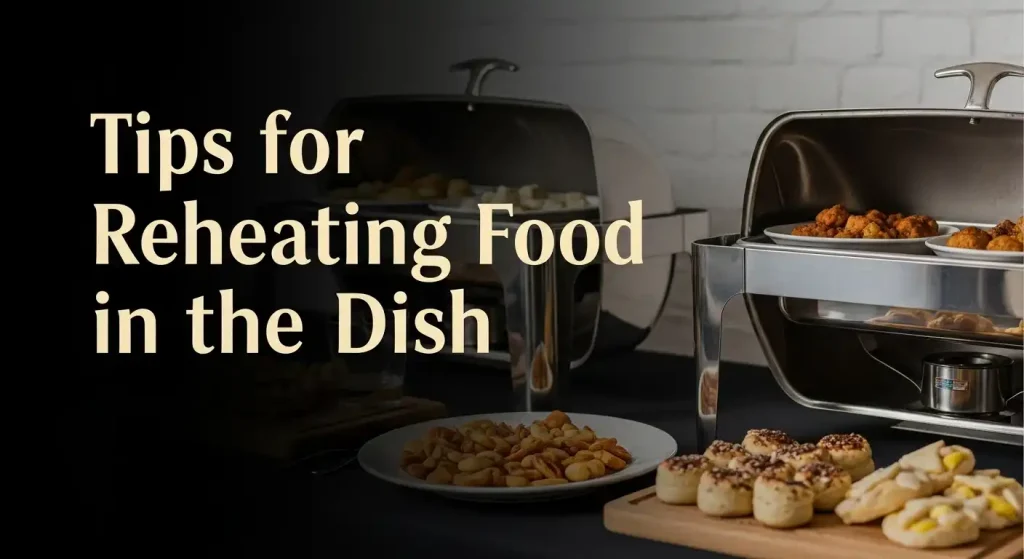
Despite the challenges, it is possible to successfully reheat food in a chafing dish if you follow a few guidelines. Here are some tips to keep in mind:
- Preheat the chafing dish: Make sure to turn on the fuel source and allow the chafing dish to heat up for a few minutes before adding the food. This will help the food heat up more quickly.
- Cut the food into small pieces: Smaller pieces will heat up more quickly and evenly than larger pieces.
- Use a lid: If the chafing dish has a lid, use it to help retain heat and speed up the reheating process.
- Stir frequently: Stirring the food will help ensure that it heats up evenly and prevents hot spots.
- Test the temperature: Use a food thermometer to ensure that the food has reached a safe temperature (165°F for most meats). Remember that it may take longer to reach this temperature in a chafing dish than using a stove or oven.
Alternatives to using a chafing dish for reheating
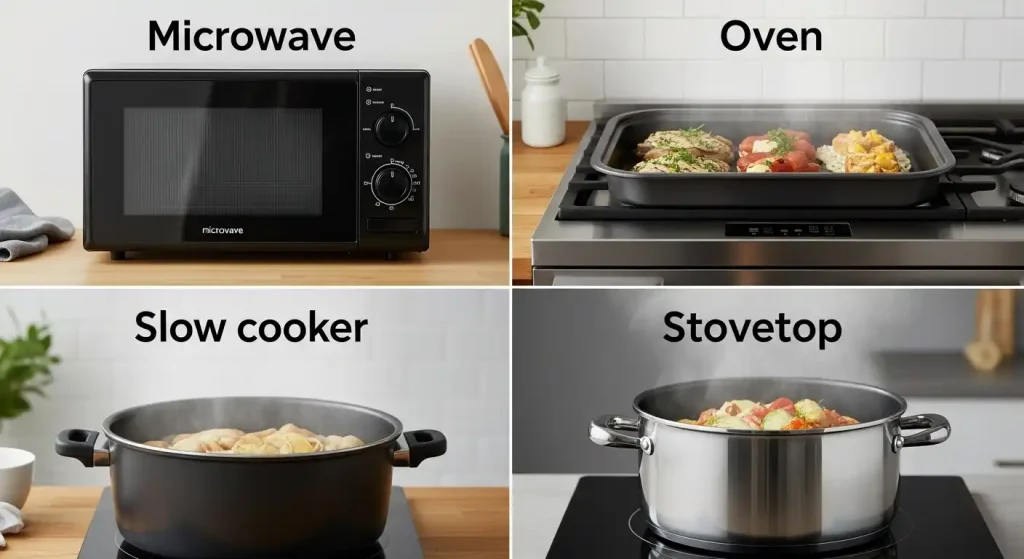
If a chafer isn’t the best tool for reheating, what else can you use? Here are some ideas:
Slow Cookers (Crock-Pots):
These are excellent for reheating or holding food. Set them on “low” and cover.
As one event planning tip notes, “Electric slow cookers are a great alternative that will keep food warm for hours without any hassle”.
They are portable and easy – cook or reheat the food in them, then keep it warm until serving time.
Electric Warming Trays or Buffet Servers:
These plug in and heat by contact. They require no water or open flame. Aleka’s party blog raves: “Electric food warmers are awesome.
🎃 Spooky Good Amazon Deals This Fall !
From cozy fall essentials to Halloween must-haves, shop Amazon’s seasonal discounts now. Don’t wait, deals vanish fast!
*As an Amazon Associate, I earn from qualifying purchases.
They do not require any water or flames and are much easier to set up”.
They often have temperature controls to keep foods at a safe 140°F. Place the food on the hot plate or in electric pans and cover them.
Heat Lamps:
Often used in restaurants, heat lamps shine infrared heat onto plates of food to keep them hot.
They are easy to use and avoid open flames.
A catering tip suggests using “a heat lamp or other source of indirect heat” to keep dishes warm and prevent drying.
Oven or Stovetop:
If you have access, simply reheat dishes fully in the oven (e.g. at 300°F) or on the stove, then put them into serving pans or chafer.
An oven can also be used as a “holding oven” at low heat to keep food warm if the buffet is quick.
Thermal Containers/Insulated Carriers:
For transporting or brief holding, heavy-duty insulated containers (like food carriers or even wrapped coolers with towels) can keep food hot.
Place the hot pans inside immediately after cooking and close tight.
Microwave/Instant Pot:
For small portions or emergencies, a microwave or multi-cooker can reheat quickly.
🎃 Spooky Good Amazon Deals This Fall !
From cozy fall essentials to Halloween must-haves, shop Amazon’s seasonal discounts now. Don’t wait, deals vanish fast!
*As an Amazon Associate, I earn from qualifying purchases.
Then transfer to whatever serving dish you prefer.
Safety and Handling Tips
When using a chafing dish, safety is key:
- Stable surface: Set the chafer on a sturdy, even table. This prevents tipping and spills.
- Watch the fuel: Use the correct canisters or gel fuel and follow instructions. Do not overfill the fuel holder. Keep fuel away from flammable items. Once lit, never leave an open flame unattended.
- Handle with care: The pans and lids get very hot. Use oven mitts or tongs to lift lids and move pans.
- Keep away from children: Make sure kids and pets stay back. Chafers and Sterno flames can burn.
- Monitor water level: Check every hour or so. If the water nearly evaporates, carefully add more hot water (avoid splashing into the food). Never let the water pan run completely dry.
- Cover the food: Always keep the lid on when possible. This holds in heat and moisture. Food stays safe and tasty, and you save fuel.
- Use clean utensils: Don’t reuse serving spoons between dishes. Use separate utensils for each pan to avoid cross-contamination.
- Check temperatures: Keep a food thermometer handy. Stir gently and ensure all food stays at or above 140°F. If something seems too cool, consider heating it more outside the chafer.
Conclusion
In summary, a chafing dish is a buffet server – great for keeping food warm once it’s hot. It isn’t meant to bring cold leftovers up to serving temperature.
Use it as directed (with water pan and fuel) to gently heat dishes and let guests serve themselves.
Remember simple tips: fill the water pan, cover the food, and keep an eye on heat. If you need to reheat food, do that in a kitchen appliance first.
Then place the hot food in the chafer for serving. By following these steps and safety precautions, your party or event will run smoothly and your food will stay delicious and safe.
Enjoy hosting your gathering with warm, tasty food that’s just right for everyone!
FAQs About Reheat Food in a Chafing Dish
How to Light Chafing Dish?
To light a chafing dish, follow these steps: 1) Place the fuel canister in the designated compartment. 2) Use a long lighter or matches to ignite the fuel. 3) Wait for the flame to stabilize before placing the food pan on top.
How to Use Chafing Dish?
Using a chafing dish involves placing a lit fuel canister in its compartment, setting a water pan above it, and placing the food pan with your dish on top. Adjust the flame to keep food warm.
Can Chafing Dishes Reheat Food?
Can You Reheat Food in a Chafing Dish: Chafing dishes are not designed for reheating food; they’re meant to keep it warm. Reheating is better done in a microwave, stovetop, or oven.
Can You Use Chafing Dishes for Cold Food?
Chafing dishes are primarily for keeping food warm. They are not suitable for keeping food cold; use other cooling methods like refrigeration or ice.
When Must You Reheat Food to 165?
Food must be reheated to an internal temperature of at least 165 °F to ensure it’s safe to eat and to kill harmful bacteria.
🎃 Spooky Good Amazon Deals This Fall !
From cozy fall essentials to Halloween must-haves, shop Amazon’s seasonal discounts now. Don’t wait, deals vanish fast!
*As an Amazon Associate, I earn from qualifying purchases.
How to Heat Chafing Dishes?
Chafing dishes are heated by placing a fuel canister beneath, lighting it, and adjusting the flame to maintain the desired food-warming temperature.
Can You Cook with Chafing Fuel?
Chafing fuel is typically used to keep food warm, not for cooking. Cooking is better done with stovetops, ovens, or other suitable appliances.
